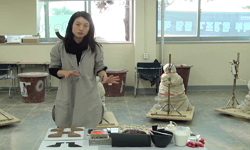This study analyzed the translation patterns of Korean, focusing on ‘ドス系, ナハル系, ハル系, ヘン系, ヤ系’ of the local languages of Kyoto and Osaka. In Korean translation, these expressions appeared in the standard language and l...
http://chineseinput.net/에서 pinyin(병음)방식으로 중국어를 변환할 수 있습니다.
변환된 중국어를 복사하여 사용하시면 됩니다.
- 中文 을 입력하시려면 zhongwen을 입력하시고 space를누르시면됩니다.
- 北京 을 입력하시려면 beijing을 입력하시고 space를 누르시면 됩니다.

작품 속 캐릭터의 지역 언어 행위에 대한 번역양상 ― 京都·大阪 화자를 중심으로 ― = A Study on Aspects of Translation of the Dialect in Cartoons : Focusing on the Speakers from Kyoto and Osaka
한글로보기https://www.riss.kr/link?id=A108741569
- 저자
- 발행기관
- 학술지명
- 권호사항
-
발행연도
2023
-
작성언어
-
-
주제어
역할어 ; 캐릭터 ; 지역 언어 ; 교토·오사카 ; 문말표현 ; 번역양상 ; role language ; character ; dialect ; Kyoto·Osaka ; the expressions of the end of a sentence ; translation patterns
-
KDC
700
-
등재정보
KCI등재
-
자료형태
학술저널
-
수록면
123-139(17쪽)
- 제공처
-
0
상세조회 -
0
다운로드
부가정보
다국어 초록 (Multilingual Abstract)
This study analyzed the translation patterns of Korean, focusing on ‘ドス系, ナハル系, ハル系, ヘン系, ヤ系’ of the local languages of Kyoto and Osaka.
In Korean translation, these expressions appeared in the standard language and local language.
In the case of ‘ドス系’ ‘ナハル系’ ‘ハル系’, ‘standard language:regional language’ were appeared as ‘-a/eoyo,-b nida…:-shu, -a/eoyu, -a/eoye, -kkai, -iso, -simnikkeo…’. In the case of ‘ヘン系’, ‘standard language:regional language’ were appeared as ‘a negative expression+-a/eo, -a/eoyo…:a negative expression+-giga, -kkigo, -kkibnideo…’. In the case of ‘ヤ系’ ‘standard language:regional language’ were appeared as ‘-a/eo, -guna, -ji…:-kkira, -ray, -kkano, aida, dei…’.
In case of expressions which were translated to standard language, characters in literary works corresponded to main characters, intellectual characters and elegant characters. In case of expressions which were translated to local language, characters in literary works corresponded to sub-characters, humorous characters, and merchant characters.
동일학술지(권/호) 다른 논문
-
日本語教育の新しい潮流と教師の質の向上 ― 日本における新たな取り組みを軸として ―
- 한국일어교육학회
- 嶋田和子 ( Shimada¸ Kazuko )
- 2023
- KCI등재
-
GAFAMが制覇しているDX、AI時代に求められるクリエイティブ日本語教育の提案 ― 「AIと外語学習」講座授業での実践成果を例に ―
- 한국일어교육학회
- 曾秋桂 ( Tseng¸ Chiu-kuei )
- 2023
- KCI등재
-
- 한국일어교육학회
- 陳多友 ( Chen¸ Duo-you )
- 2023
- KCI등재
-
「してもらう」文の文タイプの移行について ― 受益性を表さないタイプを中心に ―
- 한국일어교육학회
- 權勝林 ( Kwon¸ Seung-lim )
- 2023
- KCI등재




 KISS
KISS




